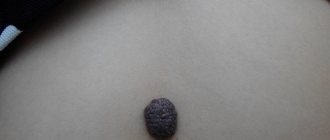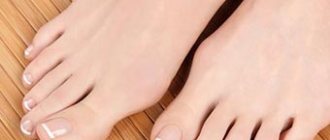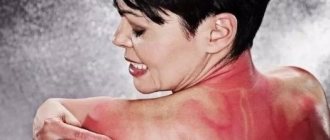More often, calluses seem to be unpleasant and unwanted companions for representatives of the fairer sex, who prefer wearing shoes that are tight, uncomfortable, small in size, and with high heels. This type of chafing is easily acquired by people who regularly undergo intense physical activity: gardeners, models, athletes.
Callus on the foot
Having received an education due to regular friction of certain areas of the skin on the leg, a person wants to pierce the blister as soon as possible. Medicine does not always recommend removing calluses on the feet yourself; this leads to a number of unpleasant and undesirable consequences. It is recommended to consult a qualified doctor who removes calluses on different parts of the skin of the human body.
Water callus: how and why it appears
In most cases, the main reason why a person suffers from unpleasant and painful formations on the feet is improperly selected shoes or inadequate protection of delicate areas of the skin from damage. For example, calluses on the feet appear due to regular wearing of uncomfortable, tight or poor-quality shoes. Wearing high-heeled shoes leads to similar consequences.
Calluses on the hands often form due to the fact that people engage in physical labor or sports without paying adequate attention to protecting the delicate areas of the hands.
In accordance with generally accepted information, modern medicine defines calluses as a consequence of regular intense friction of certain areas of the skin. Increased friction leads to abrasion of the surface layer of the skin (epidermis), the deeper layers begin to release liquid into the stressed area, causing a feeling of discomfort. A callus formed over the location of blood vessels is called a blood callus. Blood callus is not dangerous, but it affects the general physical and mental condition of a person.
Water education
About the problem
A callus is a gray or yellow growth on the skin that occurs as a result of prolonged external physical impact on the tissue. In this way, the body tries to protect itself, that is, it produces an additional, thicker layer of skin. Symptoms: redness, thickening of the skin, pain when touched. A blister is a bubble filled with fluid that leaks out when injured.
Most often, such seals occur on the arms or legs. In the first case, the cause is certain physical work: the work of a seamstress, a rural worker, a builder; athletes and pen workers are also at risk. Calluses on the foot are the lot of lovers of beautiful but uncomfortable shoes.
There are water and blood types of callus. In the first case, liquid accumulates in the layers of the epidermis. If the localization of the growth is near the blood vessels, then it is called accordingly.
As you know, any problem is easier to prevent than to fix. To prevent the appearance of calluses on the body, wear comfortable shoes, use gloves during heavy physical activity, and sprinkle talcum powder on the “threat” areas, since wet skin is more susceptible to friction. Take a course of vitamin A, which is responsible for the production of skin layers. At the first sign of a growth, use a bactericidal patch, after lubricating the area with vegetable oil. Do not neglect simple rules, because we are talking about your health.
If a callus does appear on your body, you should not neglect it. Treatment includes external and internal therapy. Most often, doctors prescribe special ointments or creams. There are also folk remedies for getting rid of an unpleasant disease. As for surgical intervention in advanced cases, opinions differ. Is it possible to pierce a callus? Let's consider all the pros and cons.
Talcum powder will help reduce friction and reduce sweating
How to prevent calluses
The best way will be to prevent the disease in comparison with its subsequent elimination. The above applies to the occurrence of calluses. It is recommended to follow these simple rules every day:
- pay attention to the choice of shoes. Products must match the size of the foot so as not to cause the slightest inconvenience. If the shoes are tight, there is no need to hope that over time the shoes or boots will be broken in;
- give preference exclusively to special shoes for certain areas of activity. For example, sports ones are for walking, stylish ones are for business meetings;
- choose socks made from natural, safe and non-toxic materials without rough seams and holes that cause dropsy;
- use gloves when working with tools made of heavy metals that damage the skin of the hands;
- wipe your feet with a dry cloth and talcum powder regularly; damp skin is more susceptible to rubbing;
- Apply vegetable oil periodically if slight redness appears on the skin of the legs;
- provide a bactericidal patch to easily prevent a small abrasion from turning into a blister or bubble filled with liquid from the deep layers of the skin at any time.
Is it possible to pierce a callus?
Doctors have different opinions about the possibility of piercing a blister at home. Thanks to the action, it is possible to get rid of painful sensations and feelings of unpleasant discomfort. If you pop the callus immediately after it occurs, the blister will heal faster than if it is left unpunctured.
Despite this opinion in favor of puncturing blisters, many medical professionals categorically do not recommend doing this at home. According to doctors' explanations, the blister becomes a natural defense of the human body and occurs due to friction of areas of human skin on the hands, fingers, legs or feet. Piercing a wet bladder with liquid leads to the formation of an open wound, which is already an easily accessible place for any type of infection and bacteria. If puncturing the callus cannot be avoided, the wound needs careful care in order to protect the body from the occurrence of abscesses and inflammatory processes due to the entry of foreign bodies into the human body.
Regarding the opinion of traditional medicine regarding calluses and removal, it is not recommended to puncture a blister without reason and necessity. The exception is the fact that the callus is localized in a place where the bubble will inevitably burst on its own, or the callus is really large in size. After puncturing the blister, you will need to treat the wound and affected areas of the skin using antiseptic pharmaceuticals.
Antiseptic
Useful tips
The more carefully you pay attention to the process, the less chance the infection has to enter the body. Below are tips you'll need during and after your callus piercing.
- In this case, do not use products with a high alcohol content as antiseptics;
- do not forget to moisturize the skin at the puncture site to prevent it from becoming rough;
- If redness, inflammation or pus occurs at the surgical site, if pain increases or if there is elevated body temperature, contact a specialist immediately.
All tips given above are guidelines only. For detailed advice, contact a specialist. Depending on the specifics of your case, he will tell you whether to pierce the callus or not. Remember that health is the basis of a fulfilling life. Take care of him!
Calluses are considered an extremely common situation for a person who is constantly on the move. It is impossible to find a person unfamiliar with such manifestations. In most cases, the bubble does not cause severe pain, it only provokes feelings of discomfort, but medicine does not recommend neglecting the treatment of formations.
More often, calluses seem to be unpleasant and unwanted companions for representatives of the fairer sex, who prefer wearing shoes that are tight, uncomfortable, small in size, and with high heels. This type of chafing is easily acquired by people who regularly undergo intense physical activity: gardeners, models, athletes.
Having received an education due to regular friction of certain areas of the skin on the leg, a person wants to pierce the blister as soon as possible. Medicine does not always recommend removing calluses on the feet yourself; this leads to a number of unpleasant and undesirable consequences. It is recommended to consult a qualified doctor who removes calluses on different parts of the skin of the human body.
Calluses that cannot be pierced
According to doctors, not all formations can be pierced manually and at home in cases of extreme necessity. Unlike blisters that contain fluid inside, human skin often develops dry and bloody calluses. If the latter appear, it is strictly forbidden to carry out piercing. Piercing is a method of removing callus fluid; in the case of dry and bloody calluses, there is no more fluid, piercing will not bring a positive result.
As for bloody calluses, the formations are closely related to blood vessels. There is a high risk of infections and bacteria entering the body through an open wound formed after piercing. Such a forecast does not allow the procedure to be performed. Otherwise, an inflammatory process will occur, leading to serious health problems in the human body; infections and bacteria that have entered the blood vessels will begin to circulate throughout the body. If bloody calluses fester, it is recommended to consult a surgeon for qualified help.
Rub or leave: What to do with calluses, corns and warts
Where there is a new pair of shoes, there are new problems: in the morning we run out of the house, grabbing a pack of plasters in advance (after all, they will probably rub), and in the evening we soak in the bathroom, trying to revive our feet.
This kind of callus is not the only growth on the skin that can cause discomfort: many also periodically develop corns and warts.
What to do with them - scratch, scrape, pierce or wait until all this goes away on its own? We'll figure it out together with a dermatologist.
TEXT: Kristina Farberova, author of the telegram channel “Chris Prints”
In the international classification of diseases ICD-11, calluses and corns belong to section EH92 - “Calls and calluses”. This is the name given to hard areas of rough skin that appear as a result of friction or pressure. Oddly enough, such growths perform their function - they protect the skin.
They can appear on any part of the body that is constantly “rubbed” - for example, guitarists may have calluses on the pads of their fingers, and many of us still have a “school” callus from a pen. For those who train with a barbell or tug of war, calluses appear on the palms of their hands.
Calluses (blisters containing tissue fluid in the upper layers of the skin) most often form on the toes and heels.
Dry superficial calluses (hard, keratinized areas of skin containing dead epithelial cells) - on the fingers and joints, appear with constant friction: blood circulation is impaired and keratinization increases.
Calluses usually form on the feet: as the name suggests, they have a core of thickened skin tissue. The most unpleasant thing about such education is the core itself. It goes deep and sometimes causes pain: such a core can put pressure on the bone or nerve endings.
The growths perform their function - they protect the skin. They can appear on any part of the body that is constantly “rubbed” - for example, guitarists may have calluses on their fingertips
Corns do not have a core - they look like uniform areas of thickened tissue and most often do not cause pain. It's easy to guess that we literally trample on corns - they appear on the inside of the foot, next to the toes.
“If calluses and corns appear on the feet once, as a rule, there is one reason: the person is wearing the wrong shoes,” explains EMC dermatologist, Candidate of Medical Sciences Elmira Gesheva. Not true to size, dense and non-stretchy, with hard, tight fasteners.
This problem can be easily solved - the damaged area of skin is treated with an antiseptic and allowed to heal, and the shoes are given for stretching.
But when we talk about systematic engorgement, this may indicate problems with the foot, gait and posture, with the distribution of weight on the feet.”
Plantar warts are a completely different story. These are benign growths on the skin; most often appear on the feet. Sometimes you can see dark spots inside the warts - these are small clogged blood vessels. As a rule, when you press on a wart, a sharp pain occurs.
Unlike calluses and corns, warts are viral in nature—they are caused by certain strains of the human papillomavirus (HPV). They enter the body through contact with the carrier or with common objects. The slightest cuts or breaks in the skin help the virus get inside. Each person's immune system reacts differently to HPV.
Not everyone who comes into contact with it develops warts. Even people in the same family react to the virus differently.
Warts are not dangerous and, as a rule, disappear on their own within a few months (sometimes several years). But sometimes they can cause complications - for example, due to discomfort, you will reflexively shift your center of gravity, which will affect your posture and the health of your spine.
If calluses occur only on areas of the foot that are subject to pressure when walking, then the wart can appear anywhere. “Calluses are often confused with warts. More precisely, they think that it is a callus, but in fact it is a wart.
There is such a thing as a skin pattern: with calluses it is preserved, with warts it is disrupted,” explains Gesheva.
Wet calluses (which we most often experience in the summer) go away on their own within three to five days. The main rule: do not puncture or cut off a blister containing fluid - this will slow down healing and increase the risk of infection.
Instead, it is better to apply a dry bandage until the fluid is completely absorbed and wear soft, loose shoes for several days. If the skin is still torn, it is worth treating the wound with an antiseptic.
There is no need to go to the doctor with such calluses, the exception being increased pain, redness, suppuration, or the reappearance of a blister in the same place.
If a callus without a core does not cause any inconvenience, then you can simply leave it alone - over time it will go away on its own, and hydrogel patches or insoles can alleviate the situation.
In a situation where you still want to remove dry, hard calluses or corns, salicylic acid is most often used; it exfoliates dead skin. True, what will be effective here is not the “children’s” one or two percent that we use in face serums, but all thirty.
A solution of salicylic acid is applied to a cotton swab and smeared on the damaged skin area, or salicylic patches are applied. They should be renewed every 48–72 hours until the callus is removed.
Sometimes doctors use products with a high concentration of urea (45%) - in this form it works as a keratolytic, softening and removing calluses and corns. It is better not to ignore the callus and show it to a specialist if possible.
It can be removed by both a dermatologist and a podologist - a doctor who works with foot diseases. Typically, such a formation is dissolved with keratolytics, cut out or drilled, and then an antiseptic agent is placed in the recess. In difficult cases, laser (laser therapy) or liquid nitrogen (cryotherapy) is used to treat core or large formations.
The worst thing you can do with a callus, corn or wart is try to get rid of it yourself
According to Gesheva, the worst thing you can do with a callus, corn or wart is to try to get rid of it yourself. Mechanical exfoliation - pumice stone, electric files - can injure the skin.
With corns it is especially easy to overdo it and rub it until it bleeds, and this is already dangerous, as it can provoke an infection; Even a salon pedicure can do more harm than good in this case. It is important to understand the reason why the skin becomes rough in these places.
“In most cases (if we are talking about systematic manifestations) this is a sign that something is not working correctly in a person’s musculoskeletal system. Either in the spine or on the feet.”
“Many pedicurists call themselves podologists - and this is incorrect,” continues Gesheva, “because a podologist is a person with a higher medical education, residency in dermatology and a narrow specialization in podology.
I often hear complaints that “pedicures don’t last long.” This happens either because they remove a lot, damaging the protective barrier, or because there is a fungal infection on the skin.
Shallow, fine cracks in the heels and big toes are often a sign of fungus rather than just hardness. And only a real podologist can understand this.”
There is no point in treating calluses and corns on your own when they are very hard - they can easily be confused with plantar warts, which require different therapy.
It is also better to remove warts from a doctor: for this they use salicylic acid in high concentrations, photodynamic therapy, laser and surgical removal.
At home, you can temporarily cover the wart with a hydrogel patch - isolation will help prevent the spread of the virus.
To prevent calluses and corns, you should first eliminate the source of chafing.
If possible, avoid wearing shoes that are too tight, always wear socks under sneakers, and put special silicone insoles or patches in shoes that rub.
You can act preventatively and use a stick like Compede - the product really reduces friction, and therefore reduces the risk of callus formation. Regular moisturizing of the skin will also help prevent the appearance of rough growths.
Home care products:
Restoring foot mask Aveeno Repairing Cica Foot Mask Callus removal patches Dr. Scholl's Corn Removers Deborah Lippmann Get Off Callus Softener Anti-Callus Pencil, Compeed
Source: https://www.wonderzine.com/wonderzine/beauty/otherbeauty/248649-blisters-and-more
Features of purulent calluses
Speaking of purulent calluses, medicine categorically prohibits the removal and puncture of such formations at home. Only surgical intervention is recommended. Doctors are obliged to prevent the formation of calluses and their transformation into purulent formations that require surgical operations. An ordinary blister can turn into a purulent formation within a week.
Regardless of the type of callus on the hand or foot, you should consult a doctor. The doctor will recommend an option for getting rid of the callus. The consequences of the development of certain types of calluses can be serious; it is better to prevent the formation of damage and immediately combat the appearance, without starting the development process for a long time.
Purulent callus
Properly opening a callus: medical recommendations
The method of properly opening a callus depends directly on the type. For example, it is better to simply seal small water bubbles with a bactericidal patch without paying too much attention. If we are talking about large calluses that are about to burst, it is recommended to open the formations, but extremely carefully and accurately. Even a large bubble cannot burst like a simple balloon. A number of rules have been developed:
- the puncture is performed within twenty-four hours after the formation of a blister on the skin;
- Before opening, the surface of the blister will need to be treated with hydrogen peroxide, the needle will need to be heated over a fire or simply treated in an alcoholic liquid;
- you need to pierce the callus from the side: the main requirement is not to touch the bottom of the formation, which is located to the occurrence of inflammatory processes. The dome of education must remain intact;
- It is recommended to make two punctures: this is done in order to prevent rupture of the skin, which has a beneficial effect on the outflow of fluid from the bladder;
- the liquid from the blister is removed using a sterile bandage or cotton wool, the skin is treated by tightly pressing cotton wool previously soaked in peroxide;
- prevent possible infection of the affected areas of the skin: the wound is lubricated with brilliant green or ointment with a special antibiotic effect. It is forbidden to lubricate with alcohol;
- When the callus has been punctured, a bactericidal patch is applied or a bandage is used as protection; it should be changed at least twice a day.
Features of callus piercing are considered in each individual case, depending on the type and degree of development on the human skin. The decision to puncture or preserve the blister is made on an individual basis. Before the procedure, it is better to first consult with a professional. The manipulation is carried out at home or in beauty salons. In any case, the main requirement for piercing remains sterility and protection from infection.
There is probably not a single person who has never rubbed calluses on his feet. Usually they pass fairly quickly, although they cause some inconvenience. For many years now, the debate has not subsided whether it is possible to pierce a callus, and what consequences this can lead to.
Alternative medicine
Traditional healers do not always provide methods that are safe for treatment, so before starting your recovery, consult your doctor.
Popular recipes:
- compresses with mashed potatoes (it is not advisable to add onions);
- aloe and Kalanchoe juice as antibacterial agents;
- special clay (sold in any pharmacy), used in the form of applications.
How does a water callus form?
Water calluses are the consequences of constant intense friction of areas of the skin, due to which its top layer (epidermis) is erased, and the deeper layers begin to secrete fluid. This is necessary to prevent further tissue damage.
The formation of calluses is a common problem for modern people leading active lives. Most often, chafing on the feet occurs in women who prefer to wear beautiful, but not always comfortable shoes. New, unworn shoes give their owners blisters on the heels, which cause pain and discomfort.
Uncomfortable shoes cause calluses
Duration of healing of blisters
Often the blisters go away on their own within 10-14 days. But for such healing to occur, it is necessary to treat the problem area with prescribed specialized medications and avoid re-traumatization of the burn site. Sometimes the blisters disappear after a week, but this is only possible with a minor burn and with almost complete absence of damage in the lower layers of the epidermis.
In circumstances where the skin has deep damage, the blister can last for about a month, that is, as long as the therapy lasts. In addition, the healing of blisters may take longer in people with particularly sensitive skin, as well as in young children. But as a rule, in this case we are talking only about a few extra days.
A burn blister on the hand causes discomfort and interferes with work
Is it worth getting pierced?
Experts disagree on whether it is possible to pierce a callus at home. Some say that this will speed up healing and help get rid of pain and discomfort. It is recommended to open drops that are too large and those that can rupture on their own. Then why is it forbidden to pierce a water callus? Some doctors argue that the appearance of such formations is a natural protective reaction of the body, and if the bubble is punctured, an open wound will remain in its place - a gateway to numerous infections. So, when opening blisters on your own, you need to provide proper care and take care to disinfect the instrument and skin in order to protect yourself from inflammation and abscesses.
Antiseptics
What calluses should not be pierced?
According to experts, not all formations can be pierced. There are several types of calluses that cannot be opened on your own: dry, purulent and bloody.
Dry corns should not be pierced due to the ineffectiveness of the procedure. There is no longer any liquid in them that needs to be released, there is only rough skin.
Blood calluses are even more dangerous; if they appear, you should seek qualified help from a doctor. If you open it yourself, an infection can get through the wound, which will circulate throughout the body through the circulatory system.
If you are wondering whether to pierce a callus or not, then look at its appearance. If it contains pus or blood, then you need to contact a specialist; such formations can only be opened by a surgeon, and in no case should you open them at home yourself. To prevent the appearance of purulent blisters, it is necessary to lubricate the inflamed area with special preparations with a disinfecting and drying effect.
Bloody and purulent calluses should only be opened by a specialist
What happens if a callus bursts? If it is a water blister, then the pain will subside and the discomfort will pass; such formations can be pierced independently. Otherwise, you need to consult a doctor.
How to properly pop a blister
Small blisters can simply be covered with a band-aid and waited for them to go away, but large blisters that can burst on their own while doing everyday activities can be opened at home.
How to properly pierce a corn so as not to harm your health:
- No more than a day should pass after the blister appears;
- Before the puncture procedure, the water bladder should be treated with hydrogen peroxide, and the needle should be disinfected with an antiseptic liquid;
- It is recommended to open the callus from the side; the dome of its formation should remain intact;
- It is better to perform piercing in several places to ensure the outflow of fluid without tearing the thin skin;
- The liquid must be removed using a sterile bandage or cotton wool, pressing a bandage soaked in peroxide to the skin;
- To prevent infection of the wound, it must be lubricated with brilliant green or special preparations with an antiseptic effect. It is forbidden to use iodine and alcohol - they cause dry skin and complicate healing;
- After piercing the callus, you need to stick a bactericidal patch or sterile bandage on the damaged area of the leg, which must be changed at least twice every 24 hours. It is allowed to use softening compresses that will prevent the skin from becoming rough;
If you notice signs of a possible infection at the site of the blister, be sure to consult a specialist.
Preventing the formation of calluses
In order not to wonder whether it is necessary to pierce calluses on the heel, it is better to protect yourself from their appearance. To do this, following simple tips will help:
- Choose your shoes carefully. It should correspond to the size in length and width, and not cause discomfort when worn;
- Give preference to socks made of natural and safe materials; they should not have holes or rough seams;
- Use talcum powder and foot deodorants. Wet skin is more susceptible to chafing and dropsy;
- Use softening creams and oils at the first appearance of redness on the skin;
- Don't forget about the bactericidal patch, which will prevent a small abrasion from turning into a blister.
Water calluses are a type of protective reaction of the skin to active friction. There is no single correct answer to the question “is it possible to pierce a callus?”, much depends on its specifics. But it is important to remember that if a blister causes concern, then it is best to consult a doctor for advice.
People encounter such a nuisance as water callus quite often. In medical practice it is also called “wet callus”, but popularly it is simply called dropsy. Women often suffer from such calluses after purchasing new shoes, men - after long work with hand tools (knife, axe, cleaver) and without protective gloves. The first question that arises in this case is whether it is possible to pierce a callus? To answer this, it is very important to consider the causes of dropsy.
Human skin consists of several layers, but the surface layer takes on all the negative effects. When the skin is exposed to temperature, pressure or friction, skin cells are able to remain unchanged up to a certain intensity of a particular irritating factor. When exposure becomes greater than acceptable, burns, bruises and calluses appear. Water callus occurs as a result of prolonged exposure to friction.
Mechanical friction over a period of time causes the surface layer of the skin to move relative to the deeper layers. As a result of this shift, the top layer of skin peels off and forms a kind of bubble filled with a transparent yellowish liquid. Moreover, the larger the area where friction affects the skin, the larger the area of skin that peels off and the larger the bubble that forms.
Is it possible to remove calluses on your hands? | Beautiful nails - complement your look
Calluses on the hands are the unpleasant consequences of prolonged hard work in the garden, peeling vegetables, playing with sports equipment or other types of activities that lead to prolonged chafing of the skin.
Calluses can be a peeling of the skin, when clear lymph fluid accumulates inside the resulting space, or a roughening of the skin, which is no less painful.
Water blisters occur as a result of performing unusual heavy work - prolonged use of a shovel or hoe, for example. The delicate skin of the hands cannot withstand such an unexpected impact, as a result of which the inner layer of the skin is damaged, while the upper layer remains intact.
Liquid accumulates in the resulting void. A natural question arises: is it possible to remove such calluses on the hands? The answer is clear - no. Water calluses should not be “opened,” cut, or any other removal procedure performed.
If you damage the upper protective layer of the skin, there is a high risk of introducing infection into open tissues, as well as increasing the natural healing time of the affected area.
Another type of callus - roughening of the skin in places of systematic rubbing, on the contrary, requires treatment, otherwise the compaction will only worsen and put pressure on the nerve endings of the tissue, causing constant aching pain and sharp pain when pressed.
This keratinized area of skin most often occurs on the protruding parts of the feet, on the soles, which is a consequence of wearing low-quality or uncomfortable shoes.
Such calluses can appear on the hands due to constant physical work with tools or sports equipment, for example.
Treating calluses on the hands is more difficult than taking preventative measures - working with fabric gloves, or when exercising on the turnstile, sprinkle your hands with talcum powder, for example, to prevent your palms from getting wet.
Vitamin A deficiency in the body also contributes to the development of calluses. In this case, doctors recommend introducing carrot juice into your daily diet, and in order for the vitamin to be fully absorbed, adding fat-containing products to it - dairy cream, yogurt, for example. It is also advisable to take vitamin supplements.
You can remove calluses on your hands in several ways - with medication, folk remedies or in a beauty salon. In a beauty salon, callus removal is carried out using a laser. During the procedure, the body of the callus gradually heats up due to the action of the laser and disappears without a trace.
Medicines for removing the stratum corneum of the skin contain various acids - salicylic, lactic and others. These products are applied to the callus and “burn” the hard, dehydrated areas. If the drug gets on sensitive tissue, a burn will occur at that location.
Folk remedies for the treatment of calluses are varied and are considered the most economical methods of solving the problem.
The most common and effective method of softening dry calluses is warm baths with soda and soap dissolved in water. To prepare the solution, you need to heat a liter of clean water to 40 degrees, add a little liquid soap intended for dry or sensitive skin, as well as a teaspoon of soda. Mix all ingredients thoroughly.
Place your hands in the bath with the solution and hold for about 20 minutes. Then the keratinized, softened area of skin should be gently rubbed with a pumice stone. After the procedure, it is recommended to lubricate your hands generously with a rich cream and wear latex gloves and mittens. This compress should be kept for 1-2 hours, and then rub the callus again with pumice.
Repeat the procedure daily until the rough skin is completely softened.
Another popular remedy for solving this problem is garlic juice. To prepare a compress, you need to grind a few cloves of garlic into a puree, put it on cheesecloth and squeeze out the juice. A cotton swab soaked in this product should be applied to the callus and secured with a band-aid. It is advisable to leave this compress overnight, wrapped in plastic cling film.
Propolis is a folk remedy that is effective in treating calluses. You can use fresh propolis or concentrated alcohol tincture. The product is applied to the problem area of the skin for several hours daily.
Calendula is a medicinal plant widely used in folk medicine in the treatment of various ailments associated with damage to the skin. The reason for its healing properties is the high content of vitamin A in this plant. Calendula flowers should be ground to a paste and applied to dry calluses overnight.
Aloe is another medicinal plant that helps fight dry calluses. To treat the skin, you need to grind a greasy leaf into a mushy state and apply it to the problem area of the skin. Apply a little Vaseline on top and stick on a bandage. The compress should be kept for about a day, after which remove the patch, rinse off the product and scrape off the softened callus.
Another popular folk remedy that helps fight calluses is a decoction of oak bark. It is necessary to make a concentrated decoction and apply a cotton swab, generously soaked in this solution, to the callus. It is recommended to wrap your hand in a woolen scarf and hold the lotion for several hours.
Purees from raw potatoes, onions, and tomatoes are also used to soften rough skin for subsequent removal.
If the top layer of skin on a water callus has been damaged, disinfectant and wound-healing lotions made from nettle, plantain and other medicinal herbs that help restore damaged areas of the skin should be applied to this area.
Calluses on the hands not only look unsightly, but also cause significant physical discomfort. You should not expect the callus to go away on its own; measures should be taken to treat it.
( -1 rating, 1 vote)
Source: https://mirnogotkov.ru/uxod-za-rukami/mozhno-li-udalyat-mozoli-na-rukax.html
To pierce or not?
To decide whether to pierce the dropsy or not, it is worth finding out what kind of liquid is in the callus. This is tissue fluid or scientifically called lymph. Tissue fluid is formed from water cells and other substances coming from the blood. Its task is to protect the damaged area from infection by microorganisms. In addition, the presence of lymph in the bladder accelerates the growth of new skin. Therefore, whether it is necessary to pierce a water bubble, everyone decides according to the circumstances.
Doctors unanimously insist that you cannot pick a callus, because there is a risk of introducing an infection into an open wound, and it is much more difficult to cure.
It’s good if the callus is small and does not cause much trouble. It is sealed with a bactericidal plaster, which will protect the damage from rupture and infection.
When a large dropsy forms, the damaged area begins to hurt, and its walls can rupture from any, even mild, impact - friction, impact or compression. For example, you need to go to work, and there is dropsy on your heel. If you put on shoes or boots, the callus on your foot will certainly rupture from the impact of the shoes.
As a result of a traumatic rupture, lymph flows out of the bladder, and a red, weeping wound forms in its place. Such wounds take longer to heal, and to prevent the callus from bursting, you have to open it yourself.
Lancing dropsy
If dropsy appears, which hurts or may burst, it must be pierced within 24 hours from the moment of its appearance. If the manipulation is carried out at this time, the negative consequences will be minimized. Subject to strict adherence to sterility measures, of course.
Procedure for carrying out the procedure at home:
- Wash your hands and skin around the blister thoroughly with soap. Disinfect the puncture site with hydrogen peroxide. There is no need to treat the puncture site with iodine or brilliant green - the wound will take longer to heal.
- Prepare a tool: a sewing needle or pin. Experts recommend using a needle in such cases, because it is sharper. In extreme cases, a pin will do.
- Be sure to disinfect the needle by wiping it with medical alcohol. If you don’t have alcohol on hand, you can ignite the needle in the flame of a candle or a gas burner on the stove.
- Make a puncture on the side of the bubble, holding the needle parallel to the surface of the skin. You should not pierce the bubble perpendicular to its surface - you may miscalculate the force, and the tip of the needle will pierce the soft tissue.
- If the surface of the bladder is large, you need to make several punctures around its perimeter, this will facilitate the outflow of lymph. Make punctures carefully so as not to tear the walls of the callus.
- Lightly press the punctured bubble with a clean cotton or gauze cloth, carefully squeezing out all the liquid.
- To avoid infection, it is important to know how to treat the wound after piercing. To do this, you need to use any available antiseptic in the form of an ointment (for example, betadine or levomekol), spreading a thin layer of it on the callus.
- Cover the treated area with a plaster or protective bandage. Place a gauze pad under the patch or bandage.
- Change the sterile dressing once a day. It is advisable to remove it at night so that the skin “breathes” - this way the wound will heal faster.
- After opening the dropsy, protect the injured area from friction or pressure, otherwise the thin skin may tear and cause more discomfort.
- If the callus fills with tissue fluid again, the puncture should be repeated.
Attention: The bandage over the callus must securely secure the wound to prevent mechanical damage to the skin. At the same time, the bandage should not be too tight so as not to interfere with free blood circulation.
Proper dissection and basic post-procedure care
Piercing a callus at home can only be done if the following rules are strictly followed:
- During the procedure, only a sterile needle is allowed to be used. You can take it from a new syringe or disinfect the sewing version with alcohol. If this means is not at hand, then it is allowed to use fire, for example, from the flame of a candle or lighter.
The use of unsterile instruments is strictly prohibited.
- The surface should also be washed with soap and water. Do not wipe off any remaining liquid with a towel. It is best to do this with a cotton pad or swab that has been previously soaked in alcohol.
- It is necessary to pierce the formation in a horizontal position. The hole is best made at the base of the blister. It is in this area that the most vulnerable surface is located.
- Two punctures will help increase the outflow of fluid.
- To remove liquid, use a sterile wipe that will quickly absorb it.
- After completing the procedure, the affected area should be treated with a disinfectant solution.
Is it possible to pierce a callus at home, watch this video:
Thanks to piercing, it is possible to completely get rid of the feeling of discomfort. The callus begins to heal faster. However, doctors do not recommend performing the procedure yourself.
Hard calluses should also be treated in a sterile hospital environment.
Otherwise, complications and severe inflammation of the skin layers, even at a deep level, may occur.
Callus care after the procedure
A wound can form without human intervention. It is important to take all necessary measures to prevent inflammation or suppuration. In this case, the following rules should be followed:
- A 3% hydrogen peroxide solution should be applied to the wound area. You can also use any antiseptic or antibacterial agent. The bandage will help prevent contamination and further injury to the area. Thanks to it, it is also possible to significantly speed up the healing process.
- Aloe helps the wound heal quickly. If it’s summer or spring outside, then it’s quite possible to use plantain leaves. They must be thoroughly washed and crushed.
- An urgent visit to the surgeon's office is necessary if the area around the callus is very red and swollen. He will be able to assess the state of education and take the necessary measures.
Doctors categorically do not recommend opening calluses yourself. In this case, the risk of infection and bacteria entering the skin increases several times. A person should not neglect this rule.
Self-medication will not give the desired effect, because only a doctor can choose the right medications. Piercing increases the risk of developing inflammation, so the procedure is strictly not recommended.
A callus is a local damage to the skin due to strong external influence, mainly of a pressing or rubbing nature. Strong, relatively short-term exposure leads to the formation of a wet callus , long-term, but moderate exposure forms a dry callus.
Treatment of a burst callus
If you puncture the dropsy in a timely manner and follow the rules, the wound will heal quickly and almost painlessly. And if a callus bursts, what should you do? This happens when you leave the house in new shoes, and when you return back, you “erase” your feet. In this case, the procedure is slightly different from the previous one:
- Treat the injured area of skin with hydrogen peroxide. Never use iodine, brilliant green or alcohol - these products dry out the skin, causing it to crack and take longer to heal.
- Do not cut off the burst bubble! Carefully apply its walls to the young pink skin located at the “bottom” of the callus. This will protect the wound and speed up its healing.
- Apply antiseptic ointment over the wound and apply a sterile bandage.
Attention: Sometimes red tissue fluid accumulates in the water callus. There is no need to be afraid - the blood vessels that are close to the surface of the skin have burst, and drops of blood have mixed with the lymph. A bloody callus is treated in the same way as a water callus.
Signs of infection
Regardless of whether the callus burst or was punctured, you need to monitor the condition of the wound in the following days. Even if all the manipulations were carried out correctly, there is always a small risk of developing an infection. The main signs of infection to look out for are:
- the presence of yellow or green pus in the wound;
- constant accumulation of cloudy liquid in the callus;
- redness around the callus;
- severe pain even without mechanical impact on the wound;
- swollen lymph nodes;
- general malaise;
- chills, fever;
- loss of appetite;
- heat.
The presence of one of these symptoms, and even more so several, indicates the development of streptococcal or staphylococcal infection. In this case, you should immediately contact a surgeon. He will be able to provide qualified assistance: he will open the wound, treat it, apply a bandage, prescribe local treatment with antibiotics, and in especially difficult cases, take medications orally.
Callus therapy
In addition to dropsy, calluses can form on the skin, which are popularly called ordinary calluses. Calluses also form in areas of constant skin friction and occur in workers of certain professions or with improperly selected shoes. Such calluses are localized on the soles of the feet, the back of the toes, palms and interdigital spaces. Calluses are thickenings of the stratum corneum of the skin and look like flat yellowish plaques.
Treatment of callus is fundamentally different from treatment of wet callus. It is steamed in hot water with the addition of soda, and then the upper horny layer is removed. Removal of callus does not occur immediately - you need to do several procedures to get rid of it completely.
How to puncture the amniotic sac
How and with what is the bladder pierced during childbirth, how dangerous is it? After manipulating the cervix (the gynecologist stretches it with his fingers), a metal gynecological instrument with a slightly bent end is inserted into the vagina. This end engages the fetal bladder and with a sharp movement pulls it towards itself. At this moment, the amniotic sac bursts, water flows out, and the uterus begins to contract.
After puncture of the bladder before birth, the baby’s heartbeat is monitored (the mother in labor is connected to CHT or periodically monitored) throughout all stages of labor. The puncture is performed only by a doctor, not an obstetrician, who will continue to conduct the birth. This procedure does not pose a danger to the child and mother. On the contrary, stimulation of labor speeds up the intensity of contractions, and the baby is born faster.
Prevention measures
Basic preventive measures will help protect the skin from friction and, accordingly, the formation of calluses and calluses:
- do not buy shoes that are too tight, hard or uncomfortable;
- when switching from winter shoes to summer ones, while breaking in new shoes, protect particularly delicate areas of the foot with a protective patch or silicone pads;
- use special sports shoes and clothing for sports;
- Do not wear closed shoes on bare feet - use socks or stockings;
- in case of excessive sweating, use special sprays or creams that reduce sweat on the feet;
- When working with hand tools (knife, shovel, broom, ax) for a long time, use protective mittens or gloves.
Dropsy is a rather unpleasant thing. It makes itself known through acute pain, depriving you of peace and comfort. Knowing what to do if a callus bursts, or how to pierce it correctly and take the necessary measures, the callus will heal quite quickly. The main thing is to comply with the requirements of asepsis, and then the infection will not be terrible. If it is not possible to cope with water callus on your own, you need to go to a hospital or beauty salon.
Tweet
Choosing the right shoes
The best measure to prevent any corns is to wear comfortable, proper shoes. You should buy it in the late afternoon, when the leg is slightly enlarged in size, and not in the morning. If you are prone to chafing, it is better to wear dress shoes for no more than 1–2 hours or avoid them altogether.
Before a long walk, you should wear shoes without rough seams, raised parts or holes; the ideal option is comfortable sneakers. You should always have plasters with you - if there is mild pain, you can seal the problem area of the leg, and a callus will not appear on it.
source











